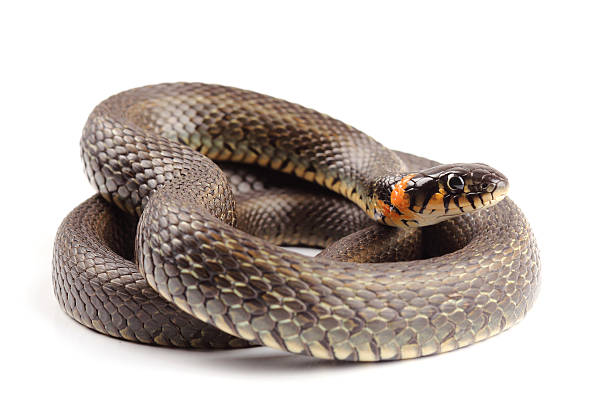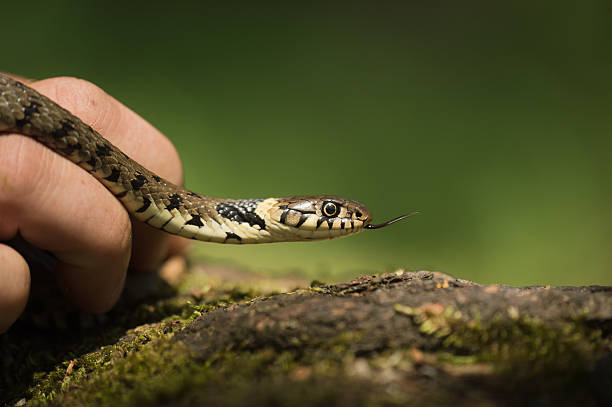
Grass snake (Natrix natrix) isolated on white background
Browse 350+ juvenile grass snake stock photos and images available, or start a new search to explore more stock photos and images.

Grass snake (Natrix natrix) isolated on white background

Grass snake (Natrix natrix) isolated on white background

Grass snake (Natrix natrix) isolated on white background

Grass snake (Natrix natrix) isolated on white background

Grass snake (natrix natrix) showing tongue

portrait of a juvenile grass snake ( Natrix ) isolated over white background
![Grass Snake (Natrix natrix) young animal The grass snake (Natrix natrix), sometimes called the ringed snake or water snake, is a Eurasian non-venomous snake. It is often found near water and feeds almost exclusively on amphibians.
Distribution:
The grass snake is widely distributed in mainland Europe, ranging from mid Scandinavia to southern Italy. It is also found in the Middle East and northwestern Africa.
This species is one of only three snakes to occur in Great Britain, and is distributed throughout lowland areas of England and Wales; it is almost absent from Scotland, and is not found in Ireland, which has no native snakes.
Ecology:
Feeding:
Grass snakes prey mainly on amphibians, especially the common toad and the common frog, although they may also occasionally eat ants and larvae. Captive snakes have been observed taking earthworms offered by hand, but dead prey items are never taken.[4] The snake will search actively for prey, often on the edges of water, using sight and sense of smell (using Jacobson's organ). They consume prey live without using constriction.
Habitat:
Grass snakes are strong swimmers and may be found close to fresh water, although there is evidence individual snakes often do not need bodies of water throughout the entire season. The preferred habitat appears to be open woodland and "edge" habitat, such as field margins and woodland borders, as these may offer adequate refuge while still affording ample opportunity for thermoregulation through basking. Pond edges are also favoured and the relatively high chance of observing this secretive species in such areas may account for their perceived association with ponds and water.
Grass snakes, as with most reptiles, are at the mercy of the thermal environment and need to overwinter in areas which are not subject to freezing. Thus, they typically spend the winter underground where the temperature is relatively stable (source Wikipedia).
Netherlands:
The Grass Snake is a quite common Species in the Netherlands. juvenile grass snake stock pictures, royalty-free photos & images](https://media.istockphoto.com/id/1277771290/photo/grass-snake-young-animal.jpg?s=612x612&w=0&k=20&c=VSC3-PsySPHuUSGC_JckV4Yf0ZouhXAIYp4gw1ZtXSo=)
The grass snake (Natrix natrix), sometimes called the ringed snake or water snake, is a Eurasian non-venomous snake. It is often found near water and feeds almost exclusively on amphibians. Distribution: The grass snake is widely distributed in mainland Europe, ranging from mid Scandinavia to southern Italy. It is also found in the Middle East and northwestern Africa. This species is one of only three snakes to occur in Great Britain, and is distributed throughout lowland areas of England and Wales; it is almost absent from Scotland, and is not found in Ireland, which has no native snakes. Ecology: Feeding: Grass snakes prey mainly on amphibians, especially the common toad and the common frog, although they may also occasionally eat ants and larvae. Captive snakes have been observed taking earthworms offered by hand, but dead prey items are never taken.[4] The snake will search actively for prey, often on the edges of water, using sight and sense of smell (using Jacobson's organ). They consume prey live without using constriction. Habitat: Grass snakes are strong swimmers and may be found close to fresh water, although there is evidence individual snakes often do not need bodies of water throughout the entire season. The preferred habitat appears to be open woodland and "edge" habitat, such as field margins and woodland borders, as these may offer adequate refuge while still affording ample opportunity for thermoregulation through basking. Pond edges are also favoured and the relatively high chance of observing this secretive species in such areas may account for their perceived association with ponds and water. Grass snakes, as with most reptiles, are at the mercy of the thermal environment and need to overwinter in areas which are not subject to freezing. Thus, they typically spend the winter underground where the temperature is relatively stable (source Wikipedia). Netherlands: The Grass Snake is a quite common Species in the Netherlands.

Young small snake isolated on white background

Close up Wild grass snake baby (Natrix helvetica) head shot

A Snake hierophis viridiflavus in Summer

Grass snake (Natrix natrix) isolated on white background

Stylized silhouette of a cute snake, cobra or natrix - cut out vector icon, sticker or decal

(Natrix helvetica) grass snake portrait face on

corn snake eating mouse in front of white background

Gras Snake in Lake Natrix Natrix Portrait. Switzerland
![Grass Snake (Natrix natrix) young animal The grass snake (Natrix natrix), sometimes called the ringed snake or water snake, is a Eurasian non-venomous snake. It is often found near water and feeds almost exclusively on amphibians.
Distribution:
The grass snake is widely distributed in mainland Europe, ranging from mid Scandinavia to southern Italy. It is also found in the Middle East and northwestern Africa.
This species is one of only three snakes to occur in Great Britain, and is distributed throughout lowland areas of England and Wales; it is almost absent from Scotland, and is not found in Ireland, which has no native snakes.
Ecology:
Feeding:
Grass snakes prey mainly on amphibians, especially the common toad and the common frog, although they may also occasionally eat ants and larvae. Captive snakes have been observed taking earthworms offered by hand, but dead prey items are never taken.[4] The snake will search actively for prey, often on the edges of water, using sight and sense of smell (using Jacobson's organ). They consume prey live without using constriction.
Habitat:
Grass snakes are strong swimmers and may be found close to fresh water, although there is evidence individual snakes often do not need bodies of water throughout the entire season. The preferred habitat appears to be open woodland and "edge" habitat, such as field margins and woodland borders, as these may offer adequate refuge while still affording ample opportunity for thermoregulation through basking. Pond edges are also favoured and the relatively high chance of observing this secretive species in such areas may account for their perceived association with ponds and water.
Grass snakes, as with most reptiles, are at the mercy of the thermal environment and need to overwinter in areas which are not subject to freezing. Thus, they typically spend the winter underground where the temperature is relatively stable (source Wikipedia)..
Netherlands:
The Grass Snake is a quite common Species in the Netherlands. juvenile grass snake stock pictures, royalty-free photos & images](https://media.istockphoto.com/id/1277771344/photo/grass-snake-young-animal.jpg?s=612x612&w=0&k=20&c=73ZrgR32-bhJlEk5S2XPxqvxYKsJxyz_RtdEJpT1vb4=)
The grass snake (Natrix natrix), sometimes called the ringed snake or water snake, is a Eurasian non-venomous snake. It is often found near water and feeds almost exclusively on amphibians. Distribution: The grass snake is widely distributed in mainland Europe, ranging from mid Scandinavia to southern Italy. It is also found in the Middle East and northwestern Africa. This species is one of only three snakes to occur in Great Britain, and is distributed throughout lowland areas of England and Wales; it is almost absent from Scotland, and is not found in Ireland, which has no native snakes. Ecology: Feeding: Grass snakes prey mainly on amphibians, especially the common toad and the common frog, although they may also occasionally eat ants and larvae. Captive snakes have been observed taking earthworms offered by hand, but dead prey items are never taken.[4] The snake will search actively for prey, often on the edges of water, using sight and sense of smell (using Jacobson's organ). They consume prey live without using constriction. Habitat: Grass snakes are strong swimmers and may be found close to fresh water, although there is evidence individual snakes often do not need bodies of water throughout the entire season. The preferred habitat appears to be open woodland and "edge" habitat, such as field margins and woodland borders, as these may offer adequate refuge while still affording ample opportunity for thermoregulation through basking. Pond edges are also favoured and the relatively high chance of observing this secretive species in such areas may account for their perceived association with ponds and water. Grass snakes, as with most reptiles, are at the mercy of the thermal environment and need to overwinter in areas which are not subject to freezing. Thus, they typically spend the winter underground where the temperature is relatively stable (source Wikipedia).. Netherlands: The Grass Snake is a quite common Species in the Netherlands.

juvenile grass snake isolated over white background ( Natrix )

a Natrix natrix snake coiled on planks, natrix natrix, wild

A male Grass Snake flicks its tongue while slithering across the knuckles of an expert wildlife handler.

grass snake showing thanatosis behaviour on ground ( Natrix natrix )

thanatosis behavior on dice snake ( Natrix tessellata )

juvenile grass snake isolated over white background ( Natrix )

dice snake showing thanatosis on a rock ( Natrix tessellata )

Grass snake (Natrix natrix) isolated on white background

Front view of a baby grass snake Natrix helvetica

Grass snakes Natrix Natrix in Latin lies under sunshine on a wooden boards. Macro shooting. Small depth of sharpness

Grass snakes Natrix Natrix in Latin lies under sunshine on a wooden boards. Macro shooting. Small depth of sharpness

A young grass snake (Natrix natrix) climbing on a wood branch. Non venomous snakes species of Europe. Snake climbing on a branch.

A young grass snake (Natrix natrix) climbing on a wood branch. Non venomous snakes species of Europe. Snake climbing on a branch.

Gras Snake in Lake Natrix Natrix Portrait. Switzerland

the snake Natrix is already very twisted into a knot in wild nature

Natrix natrix (Grass snake), Guča in Serbia

Natrix natrix (Grass snake), Guča in Serbia

Natrix natrix (Grass snake), Guča in Serbia

Young grass snake (Natrix natrix) in hand on a male phone.

Grass snakes Natrix Natrix in Latin curtailed in a ball lies under sunshine on a wooden boards. Macro shooting. Small depth of sharpness